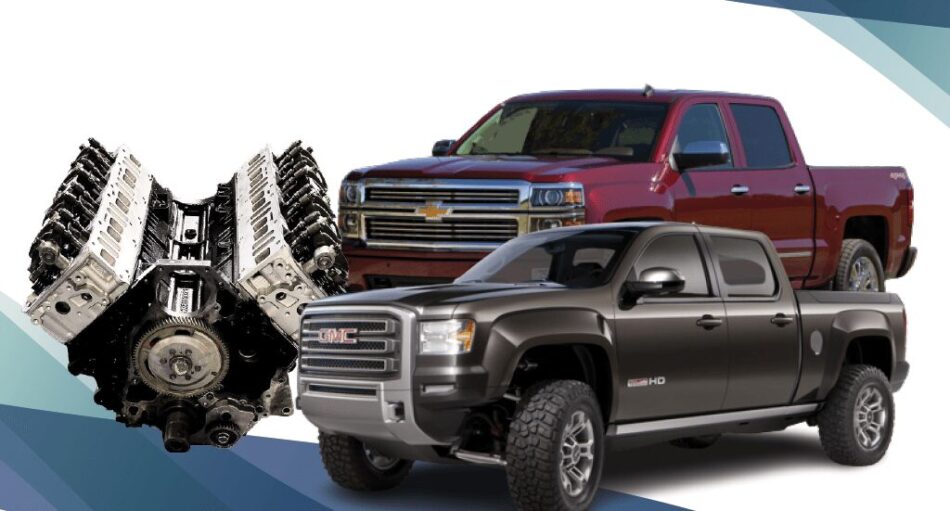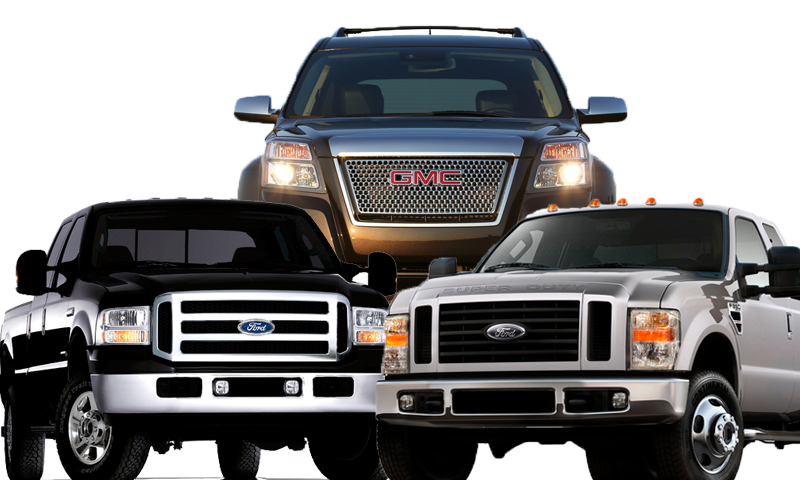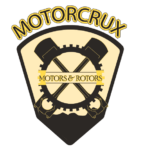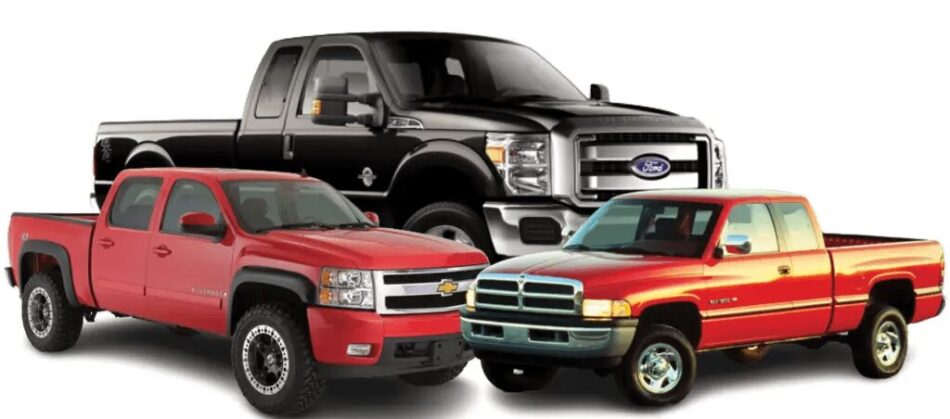Best Duramax Engines: For Pickup Trucks

In this deep dive into the best Duramax engines, we’ll look at rigs that have redefined towing, and hauling, and pushed the limits of what a truck can do.
From the famous LB7 that started the revolution to the cutting-edge L5P that’s making its mark on the present era, each Duramax engine has its personality, growl, and place in the hearts of enthusiasts all over the world.
But, which are the best?
Let us dig in.
Best Duramax Engines - LB7
The Duramax 6.6L LB7 engine deserves a place in the Automotive Hall of Fame. The LB7, which debuted in 2001, not only symbolized the beginning of the Duramax legacy but also marked a new era of power and performance in the truck world.
The LB7 was designed specifically for towing, making it popular among truck enthusiasts who needed to move hefty loads. Because of its huge torque output, it could easily tackle steep gradients, pull trailers, and manage the demands of commercial applications without breaking a sweat.
Let’s get inside the hood and look at the major features that set the LB7 apart, while also addressing the dependability concerns that early users raised.
Key Features
The LB7 engine was the first to use an advanced common-rail injection system in a diesel engine. This breakthrough in fuel delivery changed combustion efficiency, increased power output, and improved fuel economy.
The common-rail design meant that high-pressure diesel was delivered into a common line, which subsequently fed individual injectors for each cylinder. This precise and efficient fuel distribution technology revolutionized both performance and pollution.
At the time this engine was released, highway consumption rates of 22 mpg were unheard of for such a vehicle, but this one nailed it.
The LB7 was designed with a combination of toughness and weight savings in mind for performance and agility. It had aluminum cylinder heads, which helped reduce overall engine weight, which was especially important for heavy-duty hauling and towing trucks.
The block, on the other hand, stayed old-school and sturdy with cast-iron construction, ensuring endurance and reliability even under extreme conditions.
Additional features included:
In its early variants, the LB7 engine produced roughly 235 horsepower and 500 lb-ft of torque.
This V8 engine has aluminum cylinder heads, which help reduce engine weight and enhance heat dissipation.
An intercooler was fitted to cool the compressed air before it entered the combustion chambers of the engine.
The LB7 engine pioneered the use of high-pressure common rail fuel injection systems. This system boosts fuel efficiency and improves combustion control.
Reliability issues to expect
While the LB7 was a pathfinder, it had serious reliability issues, primarily with the injectors. Some owners experienced problems with gasoline injectors malfunctioning or leaking fuel. As a result, your truck may experience rough idling, low fuel economy, and possible engine damage.
Another issue that arose was with the Bosch CP3 high-pressure fuel pump. Failures in this component could lead to inadequate fuel delivery and poor performance.
Overheating was reported in LB7 engines, which sometimes resulted in cylinder head fracture. This problem may be aggravated by large loads or towing, placing strain on the engine’s cooling system.
This engine powers the Chevrolet Kodiak, the GMC Topkick the Chevrolet Silverado, and the GMC Sierra.
Despite the difficulties highlighted, this rig developed a cult following among truck fans and builders alike. Its performance potential, along with excellent aftermarket support, turned it into a blank canvas for customization, ranging from light tweaks to high-powered performance enhancements.
Best Duramax Engines - LLY
The LLY, like its predecessor, excelled at towing and hauling. Its high torque output made it ideal for big loads, and the improved efficiency meant drivers could undertake difficult chores with confidence, knowing they were getting the most out of their fuel.
The LLY engine was designed to last a long time. It inherited the older Duramax engines’ sturdy architecture, with features such as a solid block, durable internals, and strengthened components that maintained its longevity under harsh conditions.
Let’s look at the primary elements that distinguish the LLY and the dependability concerns that drivers encounter.
Key Features:
The variable vane turbocharger was a key component of the LLY engine. This innovation, unlike typical fixed-vane turbos, allowed the turbo to modify its vane angles on the fly. This dynamic adaptation maximized boost delivery across various RPM ranges, resulting in increased throttle response and power delivery.
The LLY also offered advances in engine electronics, allowing for more control over fuel injection timing and optimizing combustion. These enhancements contributed to increased fuel efficiency and smoother operation, which aligned with both performance and environmental concerns.
Reliability Issues to Expect
While the LLY made advances, it inherited some of the LB7’s injector-related issues. Injector failures were observed by drivers, resulting in concerns such as low fuel economy, harsh idling, and even engine misfires. These issues were especially noticeable in units created early in the LLY’s production cycle.
The introduction of exhaust gas recirculation (EGR) systems, which were supposed to cut emissions, brought with it its own set of problems.
The EGR cooler, which was in charge of cooling recirculated exhaust gases, was prone to clogging and failure. This could result in decreased engine performance, increased emissions, and engine damage.
Turbocharger Blues: While the variable vane turbocharger was a miracle, it wasn’t without flaws. Some drivers have reported turbocharger failures, which can result in lower power output and poor acceleration. To address these concerns, turbochargers had to be replaced, which took time and money.
Duramax recognized the reoccurring injector issues and sought to improve injector design and production methods to improve dependability. They also modified EGR system components to address congestion and failure issues.
The LLY engine, like the LB7, has a devoted following in the diesel tuning and customizing community. Because of the engine’s solid base and the possibility for performance enhancements, it became a blank canvas for enthusiasts looking to increase power and torque for a variety of applications.
You’ll find this engine under the hood of the Chevrolet Silverado and GMC Sierra .

Best Duramax Engines - LBZ
The Duramax 6.6L LBZ engine is one of the crown jewels of the Duramax series, and it has earned its spot as one of the top Duramax engines.
The LBZ, which debuted in 2006, had a startling 360 horsepower and a mind-boggling 650 lb-ft of torque.
It replaced the LLY engine and was used in Chevrolet and GMC trucks from 2006 to 2007.
Let’s take a look at the essential qualities that propelled the LBZ to the forefront, as well as the dependability factors that set the stage for this powerhouse.
Key Features:
The LBZ V8 engine came to life with a performance focus that set a new standard. Its updated engine control module (ECM) programming, paired with an upgraded turbocharger design, resulted in a significant increase in horsepower and torque.
Duramax took durability seriously when designing the LBZ. Internally, it was strengthened with a forged steel crankshaft and hardened connecting rods. This strong base not only increased strength but also enabled more confidence in towing and hauling capabilities.
The LBZ’s injectors were one of its most notable achievements. Unlike its predecessors, the LBZ was able to considerably reduce injector-related problems. Duramax’s efforts to improve injector design and manufacturing methods paid off, resulting in fewer occurrences of injector failure and fuel leakage.
Additional features
The Bosch CP3 high-pressure fuel pump, which was known to cause problems in previous models, operated better in the LBZ. The enhanced gasoline distribution system resulted in fewer fuel system glitches.
The LBZ also solved turbocharger difficulties, which was a source of relief for truck owners.
Duramax considerably increased the engine’s dependability quotient by improving fundamental components, refining production methods, and conducting rigorous testing.
In numerous ways, the LBZ symbolized the end of an era. It was the final Duramax engine without diesel particulate filters (DPFs), making it very desired for people who value the power and simplicity of pre-DPF diesel technology.
This engine powers the Chevrolet Silverado, Chevrolet Kodiak, GMC Sierra and the GMC TopKick.
The LBZ cemented its place in truck fans’ hearts, becoming a sought-after engine for both stock and customized applications.
Best Duramax Engines - LMM
The Duramax 6.6L LMM engine delivered both power and efficiency. It replaced the LBZ engine and was used in Chevrolet and GMC trucks from 2007 to 2010.
With a combination of power, ingenuity, and adaptability, the Duramax 6.6L LMM engine wins its spot as one of the top Duramax engines in the series.
The LMM engine, with 365 horsepower and 660 lb-ft of torque, continued the Duramax history of producing significant power.
What truly distinguished the LMM was its precise power delivery. The combination of a common rail fuel injection system and a variable geometry turbocharger optimized torque across a wide RPM range, resulting in smoother acceleration and improved drivability.
Let’s take a look behind the hood and see what makes the LMM unique, as well as what to look out for in terms of dependability.
Key features
In a V8 configuration, this engine has a displacement of 6.6 liters. It was turbocharged, and the gasoline was fed by a common rail fuel injection system.
The LMM engine has aluminum cylinder heads, which aid in reducing engine weight and enhance heat dissipation.
Reliability check
The eco-boosters were not without flaws. The EGR and DPF might become clogged at times, resulting in performance drops. While they had good intentions for the environment, they needed some TLC to keep things running smoothly.
A few drivers experienced heat difficulties while using the new eco-gear. When lifting big loads, the engine compartment may become overheated, producing headaches.
On the plus side, turbo issues were minor with the LMM. The turbo held up well, displaying fewer signs of problems and providing drivers with a more dependable ride.
Duramax addressed EGR and DPF issues head-on by improving components and providing care instructions. This places the 6.6L LMM engine among the finest Duramax engines.
The Chevrolet Silverado HD 2011–2016 and the GMC Sierra HD from the same years have this engine.
Best Duramax Engines - LML
The LML engine was introduced in 2011 amid a period of strict pollution laws. Despite this issue, the LML was able to offer exceptional power while meeting these requirements.
From 2011 to 2016, the LMM engine was utilized in Chevrolet and GMC trucks.
Its advanced emissions control systems, which included a diesel particulate filter (DPF) and a selective catalytic reduction (SCR) system, demonstrated General Motors’ commitment to environmental stewardship without sacrificing performance.
The LML engine drove Duramax power to new heights, producing 397 horsepower and an astonishing 765 lb-ft of torque.
There was even more…
Key features
The LML was no stranger to intelligent controls. It had fine-tuned engine control to ensure that fuel was burned efficiently. This meant not only better mileage but also a smoother ride.
In a V8 version, the engine has a displacement of 6.6 liters.
Like its predecessors, but with direct fuel injection.
The LML engine developed around 397 horsepower and 765 pound-feet of torque, making it one of the most powerful Duramax engines available at the time.
The aluminum cylinder heads of the LML engine were maintained, decreasing weight and enhancing heat dissipation.
The engine also has an intercooler to withstand extremely high temperatures.
A high-pressure common rail fuel injection system was also added to improve fuel efficiency and combustion control.
Reliability insights
While the LML’s emissions technology was a success, the selective catalytic reduction (SCR) system occasionally malfunctioned. System blockages, for example, could cause power outages, reminding us that even green technology requires vigilance.
The turbocharger on the LML wasn’t always reliable. Reports of turbocharger problems appeared on occasion, affecting performance and causing some unpleasant surprises.
The LML came with a diesel particulate filter (DPF) that needed to be serviced regularly. Ignoring DPF maintenance may result in difficulties such as poor engine performance and excessive regenerations, reducing power and efficiency.
Duramax provided solutions for SCR system problems while emphasizing regular maintenance. Turbocharger issues were tackled with upgrades in the pursuit of a smoother ride. Duramax also emphasized the significance of proper DPF care to keep everything working smoothly.
The most iconic trucks with this engine are the Chevrolet Silverado HD, and the GMC Sierra HD.
Before manufacturing ceased on the LML, most of the glitches had been addressed.
The majority of trustworthy suppliers of crate engines offer documentation that includes installation guidelines, warranty information, and any essential technical data.
Best Duramax Engines - L5P
The 6.6L L5P engine is the most recent iteration of General Motors (GM) Duramax diesel V8 engine for heavy-duty vehicles. It replaced the LML engine in Chevrolet and GMC trucks beginning with the 2017 model year.
This beast not only has amazing muscle, but it also has cutting-edge technology for a smarter, cleaner ride. Let’s look at what makes the L5P a true titan and what to look for in terms of dependability.
Key features
When it comes to power, the L5P doesn’t hold back. Its strong turbocharger produces plenty of torque, making it ideal for hauling heavy loads and navigating difficult terrain.
Other aspects include
A displacement of 6.6 liters combined with a V8 configuration
Turbocharged with direct fuel injection for increased power output.
The L5P engine generates approximately 445 horsepower and 910 pound-feet of torque, making it one of the most powerful and torque-rich Duramax engines.
The aluminum cylinder heads, intercooler, and common rail fuel injection from prior engines were carried over to the L5P engine.
Reliability insights
To reduce emissions, the L5P features diesel exhaust fluid (DEF). However, hitches in the DEF system may occur, reducing performance if not resolved.
The L5P, like many modern diesels, needs regeneration to keep the emissions system in check. Skipping regimens or driving too quickly may result in difficulties such as diminished power and fuel efficiency.
Some drivers experience cooling system issues, such as overheating, especially when driving under heavy loads.
Duramax gives guidance on DEF system care, emphasizing the importance of regular maintenance. Adhering to recommended driving behaviors and being aware of regeneration difficulties can assist in reducing regen-related concerns.
Duramax also advises on adequate cooling system maintenance to keep things working smoothly.
Closing Thoughts
From the LB7’s roaring torque to the L5P’s refined power, these engines aren’t simply technical wonders; they’re legends in the making, each with its narrative to tell.
The Duramax engines stand tall, reminding us that often the most amazing things occur with the turn of a key and the roar of an engine.
That’s a wrap on the best Duramax engines hoping you gained insights on the best pick.
Top picks

Worst Pickup Truck Engines
Picking the worst pickup truck engines is a race between Ford, GM (Chevy), and Dodge (RAM) plus a Nissan engine.


